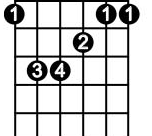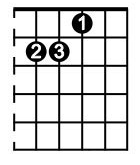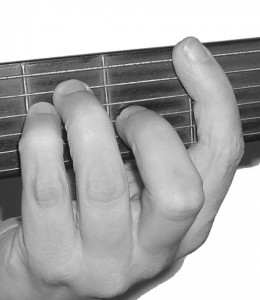What is a barre chord?
The barre chord is a movable chord that uses the first finger to lie across the strings pressing them all down whilst other fingers fret chord shapes.
Effectively your first finger becomes the guitar nut or works like a capo.
Understanding how a barre chord works can take some real thought.
It’s simple when you know how it works, not so simple in the explanation.
I’m going to try to break it down into bite size chunks.
Let’s start with the chord shapes themselves,
:::Click image to enlarge pictures:::
Major Barre Chord: E string
Guitar Neck: Bottom ‘E’ string in Red
:::Click image to enlarge pictures:::
The above pictures show a ‘Major Barre Chord’ Shape and the ‘neck’ of the guitar.
If you look closely to the guitar neck I’ve highlighted the ‘Bottom E’ string in red.
If you now look at the barre chord image you’ll see the first finger stretched across the fret board.
Where the first finger presses on the ‘Bottom’ E string is the root note of the chord.
The root note on the barre chord and the highlighted string on the guitar neck are tied to one another.
Take another look at the barre chord,
If you remove the first finger you’re left with the familiar chord shape of’E’ major
In the ‘F’ major chord shape the ‘E’ is shifted 1 fret up the neck and your first finger then ‘barres’ the strings.
So we have two things to learn.
Which shape and which fret.
This can be where confusion can start.
So let’s start simply by splitting the elements.
Example: A Major Barre Chord.
Let’s split the important info.
1. A
2. Major
The ‘A’ is our root note.
The ‘Major’ is our shape.
So the two points of information should form our chord.
How do we decide how to go forward?
Well we need to understand first how to achieve the ‘A’ root note part.
For this example let’s stick with the ‘E’ string,
First we need to learn the notes on the bottom ‘E’ string of the guitar.
Take a look at the image below(click on it to see a larger version)
A before the ‘E‘ string is highlighted in red remember the ‘E‘ is the THICKEST string.
To find the A for our chord take a look at the image above – you’ll see that the A is located at the 5th fret.
By pressing down the ‘E‘ string on the 5th fret you’ll be playing the A note.
By choosing the correct ‘Barre’ chord shape and playing it on the 5th fret you will get the chord.
How do we choose the correct shape?
There are 4 Barre c hord shapes that we use a lot, 2 of these are linked by root to the ‘E’ string.
These two shapes are below,
Major Shape
Minor Shape
Remember the example chord we wished to find was the ‘A Major’ as a ‘Barre’ chord.
So we have found the ‘A’
from the above barre chord shapes we choose the ‘Major’ shape,
With your 1st finger on the 5th fret playing the above ‘Major’ shape you are now playing the ‘A Major’ as a barre chord.
Below is a photograph of how the barre chord should look if you’re not altogether sure.
By switching the barre chord shape you can change the chord.
Play the minor barre chord shape instead of the major.
So we have the ‘A’ at the 5th fret,
by playing the above ‘Minor’ barre chord shape we are now playing the ‘A Minor’ barre chord.
Give it a try and see if you can figure out more barre chords.
If you’re still unsure then why not try looking at the following post ‘Online Barre Chord Dictionary’
Working with ‘Barre’ chords is confusing at times and like anything takes time, patience and repetition for the information and understanding to sink in.
:::Additional info:::
Looking for sharp or flat chords?
The above picture shows the notes on the guitar,
To sharpen a note raise(move) the note 1 fret up the guitar.
Now the note has been sharpenend, therefore the note would be as so,
If we played a Major barre chord shape on the 2nd fret this would give us an F# Major.
If we play the Minor barre on the 2nd fret this would give us the F#Minor.
To flatten a note lower(move) the note 1 fret down the guitar.
Now the note has been flattened, therefore the note would be as so,
As you can see from both examples of F# and Gb they are bothe the same note.
This goes for other notes on the neck of the guitar.
G#(sharp) = Ab(flat)
A#(sharp) = Bb(flat)
C#(sharp) = Db(flat)
D#(sharp) = Eb(flat)
There are no E sharps of F flats.
Remeber,minor,
To sharpen raise.
To flatten lower.










